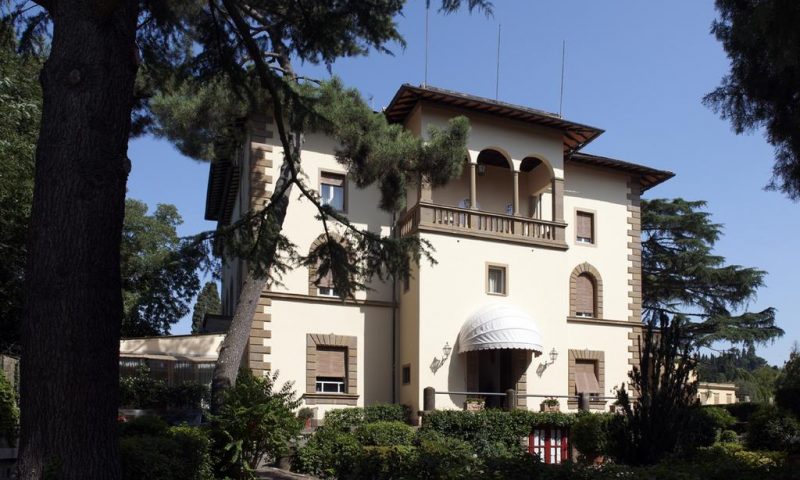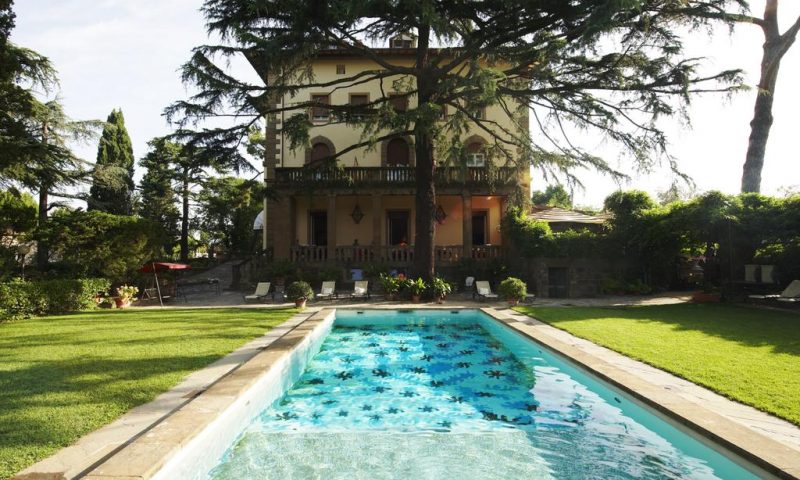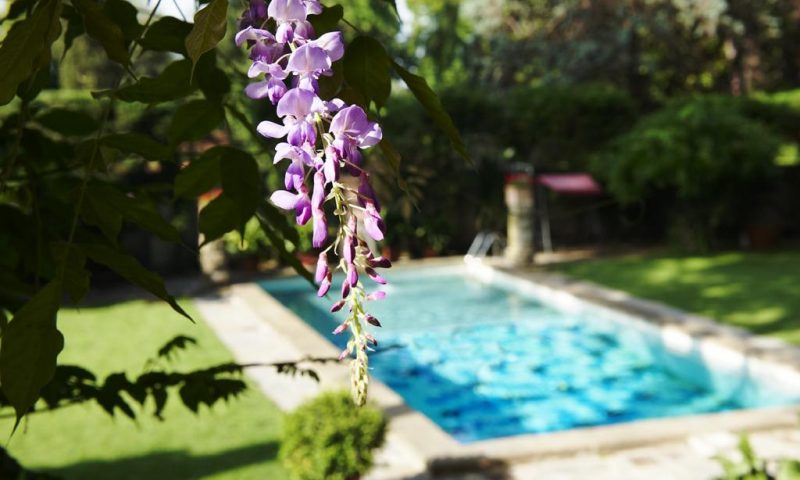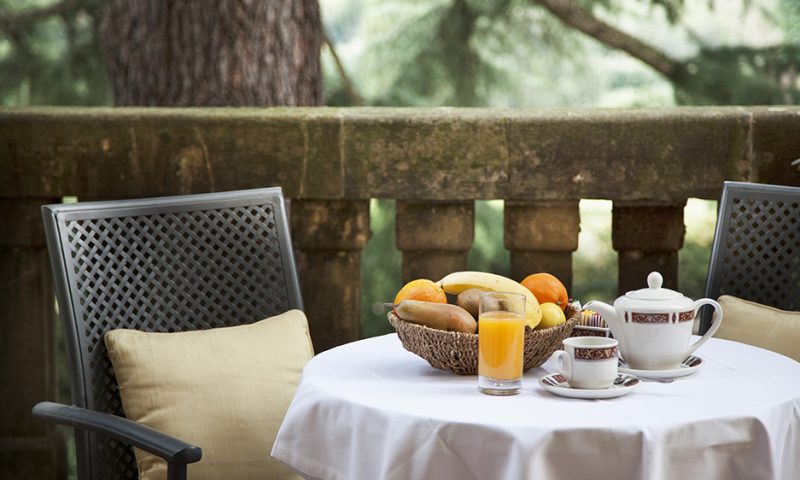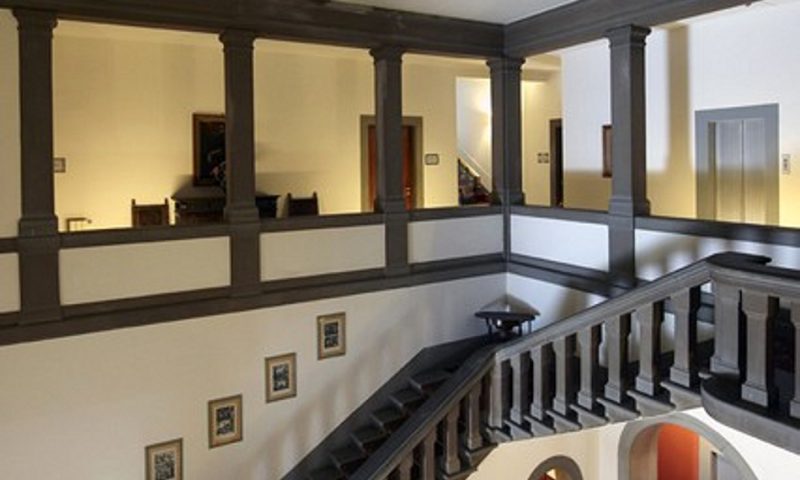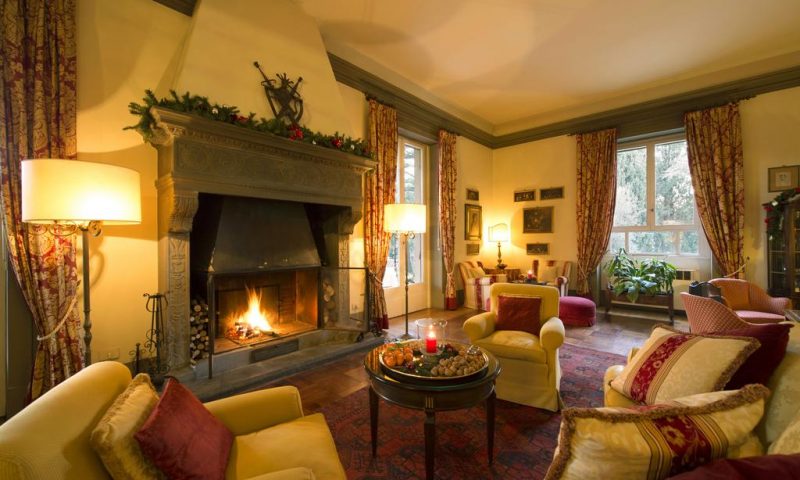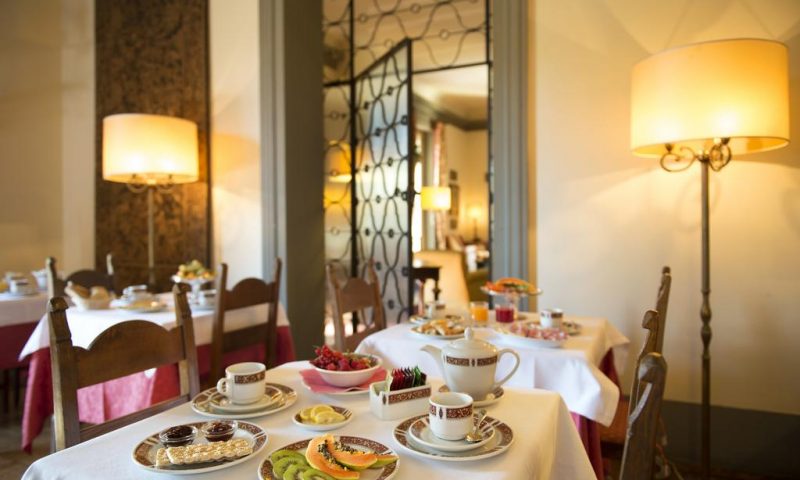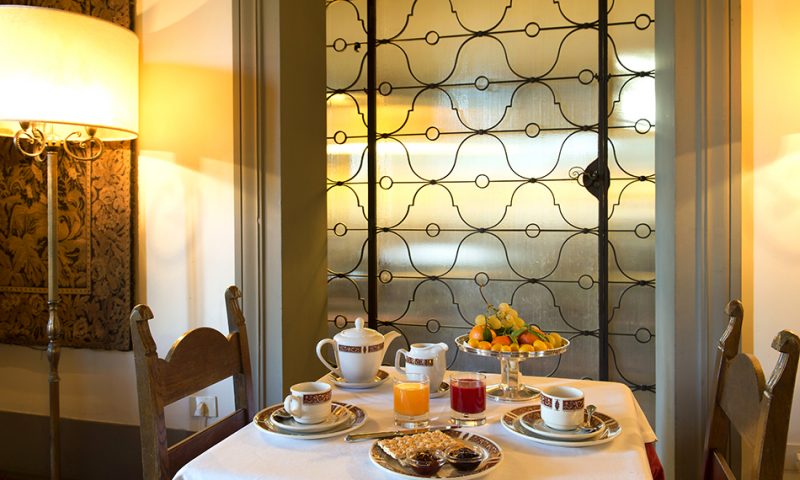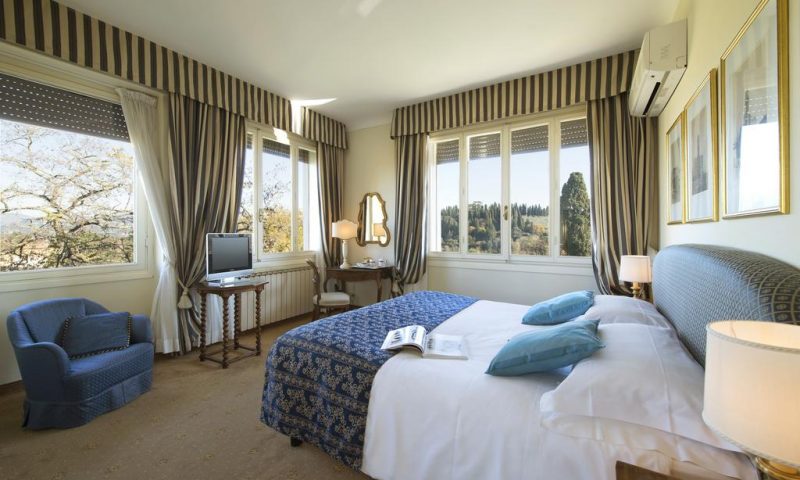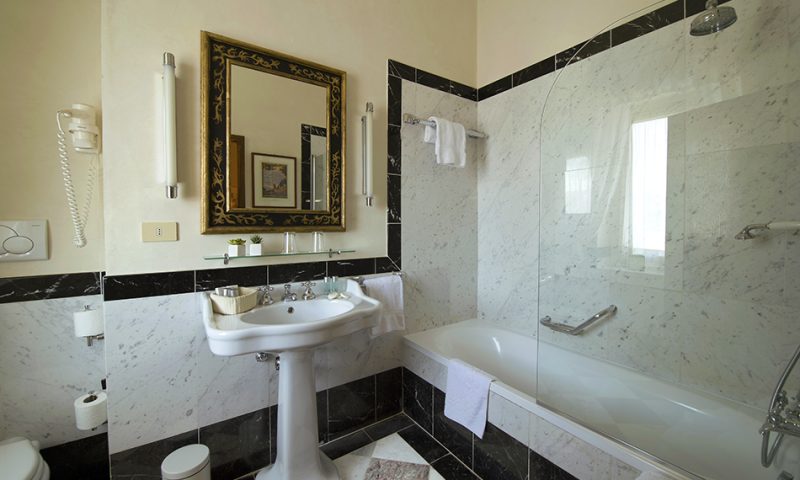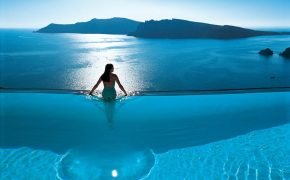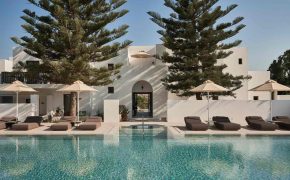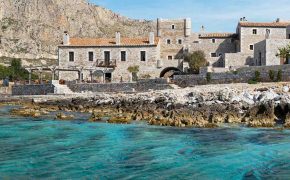Admire the unique view from your own balcony or bedroom window, have a glass of cool white wine on the terrace, and enjoy the Park Palace, your Florentine Villa.
A real Florentine style Villa which offers a cozy atmosphere throughout the entire Hotel and its 26 lovely rooms. Only minutes away from the historical centre of Florence where one can visit all of the most famous monuments like the Florence Dome, Palazzo Pitti, and the Uffizi.
Near the Boboli Gardens and Ponte Vecchio, the Park Palace Hotel offers its guests an array of modern comforts within a relaxing and refined environment and an exquisite panoramic view of the city.
ROOMS & SUITES
All of our 26 rooms are delightfully furnished offering all modern amenities and comforts including: Wi-Fi, air conditioning, mini-bar, satellite TV, safety deposit boxes.
DOUBLE ROOM
Double room for single use. Delightfully furnished offering all modern amenities and comforts including: air conditioning, mini-bar, satellite TV, safety deposit boxes.
DELUXE ROOM
Doubleroom large with either view or balcony. Offers all modern amenities and comforts including: air conditioning, mini-bar, satellite TV, safety deposit boxes.
JUNIOR SUITE
Large twin room with either terrace or panoramic views, for two persons doublebed on request and sitting area.
FAMILY ROOM
Quadruple room ideal for families with parents and two children. This large room has air conditioning, carpeted floors, a spacious bathroom and an LCD TV with satellite channels.
SUITE
Large Room with separated little sittingroom and terrace with panoramic view. Large double room (two beds) with separate living.
SERVICES
- Breakfast: from 7.30 am until 9.30 am, in the breakfast room, in summer on the terrace, we serve a rich breakfast buffet.
- Wi-Fi: Wi-Fi is free on all areas and rooms.
- Meetings and Banquets: we provide three conference / banquet rooms of various sizes, with seating arrangements from 12 to 90 people.
- Bar: good choice of alcoholic drinks and snacks even in your living room or terrace
- Reading Lounge: the hotel has an elegant and romantic reading lounge with a fireplace.
- Room Service: opportunity to have a snack in the room.
- Swimming Pool: the Hotel is surrounded by a magnificent garden in which there is a swimming pool with lounge chairs and beds.
- Concierge: the Staff at Park Palace Hotel Florence will be more than happy to assist guests with: tickets for museums, exhibitions, trains and flights; tourist itineraries and maps; car rentals with or without private driver; guided tours; mailing; printing and photocopying; baggage deposit; and currency exchange. Baby-sitting services are also available upon request for a fee for services.
- Laundry Services: one-day dry cleaning and laundry services are available on request.
- Parking: inside the park closed during the night or on the piazza Galileo. Both parking solutions require a fee. Hotel parking can be booked directly on this site.
ARCETRI’S ASTROPHYSICS OBSERVATORY
Arcetri’s Astrophisics Observatory is an Italian professional, astronomic observatory, which belongs to INAF (Astrophysics National Institute).
Its origins derive from the Specola that adjoins the Physics and Natural History Museum, which is situated in Via Romana in Florence. As a consequence of the complex political successions connected with the French occupation of Tuscany, the Museum becomes an institution of the Etruria Kingdom.
Pietro Leopoldo, Grand Duke of Tuscany wanted the Observatory, while in 1807 the Queen of Etruria, Maria Luisa of Borbone, consecrated the ” Royal Museum” for public education and established there six professors.
During the same year 1807, Domenico De Vecchi, one of the professors who settled there, held an astronomic theoretical-practical course, at the same time , he was carrying out astronomical and metereological observations.
In fact, De Vecchi dedicated himself to the museum “specola” observing the position of the stars, comets, eclipses with the aim of studying weather and longitude.
When he died, the Frenchman Jean-Luis Pons, who became famous for the discovery of comets in Marseilles, succeeded him and, during his stay in Florence he continued to discover other comets.
In 1831, Grand Duke Leopoldo II appointed the modenese optician G. B. Amici to direct the florentine specola. G.B. Amici was already known in the field of astronomy and geodesy for his objectives and lenses; he brought other fellows from Modena with him who contributed to the revival of the optical traditions and mechanical precision found in Florence.
The construction of two objectives for telescopes , which are still in existence at the Observatory belongs to him. In 1859 his pupil G. B. Donati succeeded him. Donati again begun the sky observation and suggested to build a new observatory on a raised area near Florence.
The choice fell to the hill of Arcetri, closed by the villa “Il Gioiello”(“The Jewel”) where Galileo spent the end of his life. On October 27 1872 the new Observatory was inaugurated and Donati commited himself in order to put it into practice, but unfortunately cholera caused his death in 1873.
The German Ernst Wilhelm Tempel succeeded him. He was a lithographic draftsman and very keen on Astronomy: he dedicated himself to the discovery and observation of comets, small planets and neboulose, of which he made a consistent quantity of important draws and reliefs that won him the Royal Award of Lincei Academy.
Antonio Abetti took over as director from 1895 until 1921. A large number of planets and comets observations have been carried out by him by the newly completed equatorial frame made for Amici’s objective.
In 1921 the Observatory activity in particular began to address to astrophysics research, under the direction of Giorgio Abetti, Antonio’s son. It gained the ufficial title of “Astrophysics Observatory”.
In 1924 a solar tower, dedicated to G.B. Donati, strenghtened the Observatory. It is 25 meters tall and has a spettroeliograph. Also the objective by Amici was substituted for a more powerful one.
In 1925 Giorgio Albetti was nominated to hold the chair of Astrophysics at the University of Florence, when, a year later, by a decree, the Observatory became a State observatory.
SWEET HILLS & SUBURBS
Suggestive views, villas and historical palaces, splendid landscapes, are what we find on this route that, although rough at spots, is particularly interesting, uniting both the art and history that characterizes it and that has inspired both Tuscan and international artists.
The stretch down the Lungarni is the easiest and possible however, to return by bus from Piazza Poggi to Piazzale Michelangelo and Viale Galileo. Route info:
- Length of route: approx. 4.5 km on foot.
- Time needed: because it is a particularly demanding route rich with interesting stops, it is suggested to do it, if on foot, in two stages throughout the day; 2 and a half hours in the morning and the remainder in the afternoon.
Leave the Park Palace hotel and turn left on Viale Galileo where at the traffic light you’ll turn left again, getting on to the suggestiveVia San Leonardo.
The street owes its name to the church named after the French saint and protector of prisoners who lived at the turn of the 5th century, and resembles a corridor, closed in by low walls where, among and between the olive trees that line it, we find splendid private dwellings.
Right on the corner of this strip of road, to your left, you will notice a villa where the great Russian musician Peter Iliych Chaikovsky lived and composed in 1878. He started a platonic, but above all epistolary, relationship with the very rich widow Nadezda von Meck who was renting the Villa Oppenheim and who was passionate about music.
The composer even dedicated a symphony to her. Now, note Villa Lauder , characterized for its red brick color and lovely Renaissance style loggia on the first floor. Continue on and at no. 49 you can see a plaque on the face of a modest house indicating the place where Ottone Rosai lived from 1933 to 1957.
The Florentine painter represented this same via, and the more characteristical corners of the street and the piazza of the Oltrarno quarters, in his paintings. Next door, at no. 41, lived Mario Pratesi , tuscan writer from the 1800’s.
You arrive now to the Church of San Leonardo from thr XI° or XII° century, and restored many times over. Inside, find the splendid 13th century Pergamo, originating from the Church of San Pier Scheriggio, where famous personages like Giano della Bella, Dino Compagni and Giovanni Boccaccio, are portrayed giving speeches.
You have almost reached the end of via San Leonardo, near the 14th century Porta San Giorgio, belonging to the sixth circle of the urban wall and attributed to Orcagna, above which you will notice a copy of San Giorgio killing the dragon, by Andrea da Pontedera.
On occasion of the siege of Florence in 1529, Michelangelo, responsible for the fortifications, suggested to lower the door in order to be less vulnerable to canon fire.
But before passing through it, we suggest a visit to Fort di Belvedere that you find on your left. The Fortezza (fort) of Santa Maria, called so by Belvedere because of the spectacular panorama one enjoys, was constructed by the wishes of Ferdinand I with the aim of endowing Florence with a fort that could defend the city from on high, but above all, to conserve the treasures of the Medici family.
The convenient access from the Boboli Gardens consented the members of the Medicean family a safe refuge in case of attack. Today, numerous open air sculptural exhibits are held here. Surpass the arch, and get on to the steep Costa San Giorgio, named after the antique Church of San Giorgio and Spirito Santo.
The church, dating back to the year 1000, was one of the main priories of Medieval Florence and it was here that the young Giotto executed work on the tabletop of the altar with the Madonna col Bambino in trono e due Angeli (Madonna and Child on the throne with two angels) that today is found in the diocesan Museum of Santo Stefano al Ponte.
Between 1705 and 1708, the interiors of the church were decorated in rococo style, but with the Neapolitan reform, the edifice and the connecting convent were taken over to host the military headquarters of Caserma Vittorio Veneto, that trained military medical and chemistry students for the Military School of Sanità.
Today, the building is seat to the Orthodox Romanian Church. The first part of this street is framed with villas with gardens that are more often substituted with medieval edifices.
On your right, at no.2 is the entrance to Villa Bardini built in 1641 on a pre-existing medieval structure. For its splendid panoramic position it was also called Villa Belvedere (belvedere meaning lovely view) and it was part of the so-called “Casini di Delizia” (pleasure houses) widespread in Florence between the end of the 1500’s and the first half of the 1600’s, created for the pleasures of the high-class and surrounded by agricultural cultivations, not only for a productive income but ornamental, as well.
Its Garden is characterized by a large Baroque stairway, English lawns, rich with medicinal and ornamental plants, ground floor terraces, occupied by olive and fruit trees, beautiful dense wooded areas and an agricultural park.
Villa Bardini organizes numerous exhibitions. At no. 17 you find the house di Galileo Galilei where, from the tower of the house, he performed his astronomical research.
Now, turn right and get on to yet a steeper but delightful street, Costa Scarpuccia, up until reaching Via de’ Bardi, first called Borgo Pidiglioso or “pidocchioso” (lice ridden) because of the destitution of the population that lived here.
With the arrival of the Bardi’s, who began to build houses and towers, the street took on the same name of the powerful and rich Florentine family.
At no. 12, in front of the famous cypress, you find house where Giovanni Papini , famous Florentine writer once lived; followed by the 11th century Church of Santa Lucia dei Magnoli , restored more times over and holds a precious Table (slab) by Pietro Lorenzetti, and other palaces of celebrated families, like the Tower of the Bardi at no. 44.
You have now reached Piazza Santa Maria Soprarno (above the Arno) where one of the most antique parish churches of the city once stood.
Erected in 1210 and called so because it was constructed on the banks of the Arno. Unfortunately, the building disappeared in 1869 concomitant with the systemization of the lungarni (along the river bank).
Now, go to your right for Lungarno Torrigiani. The name derives from an important Florentine family who originally possessed a tower-house in the city center, relocating later to the oltrarno (other side of the Arno) where they had various palaces built, among which including the magnificent Palazzo Torrigiani that you will encounter farther ahead. Go through the public park that the Lutheran Church faces, leaving behind you the Ponte alle Grazie.
At one time, this bridge was called Ponte di Rubaconte after the name of Podestà who had it built in 1237, later named “delle Grazie” because of the presence of a 14th century tabernacle that contained a Giottesque “Madonna delle Grazie” much adored by the Florentines. Many crossed the bridge; ambassadors, princes, cardinals, who, transiting Florence, were guests in the Mozzi houses, a little farther ahead.
Go now to Piazza de’ Mozzi, name of powerful banker who, in 1300, managed the Papal Treasury. In this little 15th century piazza you will admire a series of splendid palaces; at no. 2 Palazzo Mozzi belonging to the family of the same name, with typical 11th -12th century characteristics, at no.5 Palazzo Torrigiani , most likely built on a project by Baccio d’Agnolo, at no.4, Palazzo Torrigiani-Nasi, decorated in graffito, the 13th century , at no.3, and at no.1, the palace where the Museo Bardini is found.
The building derives from the transformation of the 13th century Church of San Ghirigoro della Pace. The antique dealer, Stefano Bardini, collected a rich private collection at turn of the 18th century, later leaving it all to the Municipal of Florence.
The collection included; sculptures, paintings, ceramic pieces, medals, small bronzes, oriental rugs, musical instruments and other findings that Bardini looked for personally through remains and debris.
The palace too presents itself as an original construction in fact, antique pieces were used on some doors, windows, architraves and elsewhere. The masterpiece of the museum is the 15th century San Michele Arcangelo (Archangel Saint Michaal) slab by Antonio del Pollaiolo.
Follow along now for Via de’Renai and at the corner with Lungarno Serristori, you can admire the Palace of the same name from the celebrated family coming from Ser Ristoro who originally bought a house in the quarters of Santa Croce, when later their descendents transferred to the Oltrarno, to the quarters of San Niccolò.
Palazzo Serristori, restructured in 1873, hosted illustrious personages like Gioacchino Murat, the Russian prince Nicola Demidoff, ,and Girolamo and Giuseppe Bonaparte. Arrive now in Piazza Poggi, whose scenery is underlined by a series of staircases and terraces set in green nature and decorated with water basins and grottoes.
They are the Rampe di San Niccolò , designed by the architect Poggi concluding on the panoramic terrace in Piazzale Michelangelo. On the right of the piazza stands Porta S. Niccolò . Constructed in 1324, it is the only one of all doors that “survived” in Florence and that has preserved its original height. Now, get on to the characteristic Via San Nicolò, that is part of the antique, Medieval, popular, artisan and borgo.
Here you can find antique shops and specialty artisan shops like that of wrought iron. At no. 60/r, you could take a break at the Antica Mescita San Niccolò, ex customs station for wine coming from Chianti to Porta San Nicolò, transformed at the beginning of 1800 into a ” grocer’s and wine tavern”.
After the flood of 1966, during restorations, the Roman crypt in the church of San Nicola re-emerged, where in its suggestive environment, one might want to stop for lunch to savour a typical Tuscan cuisine.
Follow on until you reach Porta S. Miniato , pass it and get on to Via San Miniato. At this point you can choose between two itineraries to go back to you hotel; the first “more difficult” and the other easy.
The first leads you on the steep flight of stairs of Via del Monte alle Croci, characterized by Via Crucis” (stations of the cross) where at the end you arrive to the Church of San Salvatore al Monte. This important Renaissance edifice, simple but rigorous structure, was built between 1499 and 1504 by Cronaca.
The window on the lateral entrance of the church was done by a design of Pietro Perugino and depicts God the Father Benedictory surrounded by cherubs and seated on a throne of clouds; the windows with Le stimmate (stigmates) of S. Francesco, Giovanni Battista, S. Antonio of Padova, S. Giovanni Evangelista are also attributed to Perugino.
Exiting the church and heading towards you left, you can go up to the 11th century Roman Basilica of San Miniato al Monte placed where a paleo- Christian church once stood.
Like the Baptistery, it is covered with white and green marble and inside holds valuable works of art like, the Chapel of Crucifix done by Michelozzo with barrel vaults, enamelled by Luca della Robbia, and the Chapel of the Cardinal of Portugal in a Greek cross design with cloister vaults constructed by Antonio Manetti.
Outside, you find the cemetery where the remains of many celebrities including Papini a Montale Stibbert, Carlo Lorenzini and others. Leaving the Church, return to Viale Galileo and turn right in the direction of Piazzale Michelangelo.
The incomparable view of what you will see from the “terrace” will have made the fatiguing walk up worthwhile. Note the Loggia, behind the statue of David, where the architect Poggi intended to exhibit the masterpieces of Michelangelo.
Today the edifice is used as a restaurant bar; you could have a coffee or an aperitif “with a view”!. . Finally, to return to your hotel, follow Viale Galileo or if you are too tired you could catch the bus no. 13 that will take you to the front of the Park Palace hotel.
If instead you do not want to take the same fatiguing walk back, you could take the easy route from Via San Miniato to Via di Belvedere, following a stretch of wall remains, saved from the demolition of architect Poggi, and go on to Fort Belvedere.
From there, retracing the street you came on, go back up Via San Leonardo and cut on to Viale Galileo Go to your right and you will arrive in Piazza Galileo.
FORTE BELVEDERE
Open from Tuesday to Sunday from 11 am to 4 pm. Closed on Christmas Eve and New Year’s Eve.
BARDINI GARDENS
(November, December, January and February open from Monday to Sunday from 8:15 am to 4:30 pm.) (March: from Monday to Sunday from 8:15 am to 5:30 pm.) (April, May, September and October from Monday to Sunday from 8:15 am to 6:30 pm.) (June, July and August: from Monday to Sunday from 8:15 am to 7:30 pm) Closed the first and last Monday of each month, New Year’s Day, May 1st and Christmas.
SAN LEONARDO’S CHURCH
Open from 8 am to 12 midday and from 4 pm to 6 pm. Chiesa Luterana Masses for parishioners twice a month on the first and third Sunday at 10 am. Concerti: In the months of April and October, every Wednesday at 9 pm, concerts of classical and organ music, chamber music and choir are held.
The German made organ was constructed particularly for Baroque music concerts. Office hours: Wednesdays and Thursdays from 9 am to 12 midday.
OLTRARNO
Although the centre of Florence is located on the opposite bank of the Arno River, important monuments, gardens and museums are found in the Oltrarno.
Palazzo Pitti, the Church of Santo Spirito, Ponte Vecchio, Giardino di Boboli, together with the craftsmen’s shops, goldsmiths, jewellery merchants and restorers make Oltrarno’s narrow streets the area of Florence where it is still possible to feel the real spirit of the Renaissance.
Florence was founded in the first century B. C. on the northern bank of the river and had its centre in the modern Piazza dell’Unità. In the early 4th century A.C. , a small group of Romans settled on the other bank, which reached the extremity of the ancient Ponte Vecchio. Merchants and travellers used to live in this area, among them a Syrian colony which distinguished itself and founded the church of Santa Felicita.
During the late Middle Ages the city “over the Arno” became bigger and more and more important: a market took place in Piazza di Santa Felicita, in the modern district of San Niccolò, where the powerful Mozzi family built a palace, which has been the biggest of the city for many years. Other noble-families built some towers, some of which may be recognized also today.
A large number of “hospitals” arose between Ponte Vecchio and Porta Romana to house pilgrims who were travelling towards Rome through the still existent Via Romana and two new bridges were built in order to develop a better connection between the two sites of the city: the Ponte alle Grazie, which was destroyed during the Second World War and rebuilt in 1957, and the Ponte a Santa Trinita, which was swept away by the floods of the Arno river.
In this way two “borghi” (villages), Borgo San Jacopo and Borgo di Piazza (today Via Guicciardini) and other settlements around the two main churches of Santo Spirito and Santa Maria del Carmine developed.
This rural and quiet area started to be seen as more wholesome compared to the northern bank characterized by relentless traffic. The Pitti, a wealthy merchant family, were among the new residents. They built the central part Palazzo Pitti, which bears the same name.
In 1550, when the Medici moved into Palazzo Pitti, the square in front of it, near Via di Maggio and other streets became very important. Here new buildings owned by families of the Medici court arose: even today, walking along Via dei Serragli, Via Santo Spirito or Via San Niccolò you can find magnificent resulting Renaissance palaces.
In 1865 many important works were made as a consequence of the transfer of the capital of Italy to Florence and led to the creation of Piazzale Michelangelo, which became the new exclusive cultural salon of Florence.
This change brought about the new style of Viale Michelangelo, which takes its name from the “piazza” on the hills and consequently it became the luxurious residential area for the new middle class of Florence in the 19th, 20th centuries.
Florence was badly damaged during the 20th century by two main events: the movement of the allied troops in 1944 and the flood in 1966. Devastating floods ravaged the city in November 1966, causing inestimable damages to its buildings and works of art.
Until today the Oltrarno has preserved the most traditional atmosphere of Florence: there are some districts, almost unknown, which offer shops, cafes, restaurants and museums and a way of life which has disappeared in other districts of the city.
OLTRARNO’S TRADITIONAL SHOPS
In Oltrarno, the ancient handcraft Florentine tradition is still alive. Walking toward this area, you will see the narrow and dark streets lined with shops and workshops such as carpenters, goldsmiths, restorers, frame-makers.
Since 1856, Giulio Giannini’s historic stationary, via Piazza Pitti, 37 offers beautiful hand-made leather note-books, and gilt diaries. From the square, reaching via dei Vellutini, 5 you will find a shop full of paintings, chandeliers, inlaid furniture and large mirrors.
These works of art are all hand made by Bartolozzi & Maioli. Taking Via Maggio, typical for its antiquary shops, you will meet the well known Zecchi’s showroom. The Florentine antiquary sells precious and rare items, which are addressed to the experts.
Continue along Via dello Sprone to visit two other interesting shops: Aprosio & Luti and Studio Puck. The first one produces magnificent spider web goods using Bohemia crystal, Venetian glass and crystal pearls. The second one produces fanciful hand painted frames.
Keep on walking until you reach San Jacopo district, where you will find San Jacopo Show, which is a very original shop and produces beautiful dummies and other goods that can be used to adorn boutiques as well as private homes.
La casa del ‘900, Borgo San Jacopo, 45, displays the typical glasses of the thirties, liberty brooches and many other jewels of the early 20th century.
The neighbouring district of Santo Spirito is also full of workshops such as Arredamenti Castorina, which provides frames of every form, style an size or the shoemaker Francesco da Firenze, who may offer an excellent assortment of hand-made shoes.
Further we enter in Borgo San Frediano, where, among new and old stores stand out the Paralume, which is a typical antiquarian shop characterized by hundreds lamps of different style and the Casa delle Bambole, which recalls the ancient handcraft tradition of laces and underwear.
In the near-by Piazza del Carmine, Filadelfo Scaparro’s shop displays a large number of wrought iron items, which are typical of the Florentine tradition.
Next to his shop, it seems impossible to see a lute-maker’s shop as that of Claudio Arezio. Ending, the Antico Setificio Fiorentino should not be missed (by appointment only). Here you will find a showroom and several workshops of the 18th century, which produce silks, velvets and damasks of incomparable beauty.
CHURCH OF SANTO SPIRITO
In 1250 A.D., Augustinian friars bought a land in Oltrarno area ( over the Arno). They thought it had a good position for their spreading activities. For this purpose they built a church and a convent, which became soon a meeting point for the workers’ family who lived in that area.
Some wealthy citizens considered the Oltrarno area as more wholesome compared to the centre of the city and, in the end of 4th century, they decided to move there. Thanks to their financial help, the church was rebuilt and expanded. Brunelleschi’s design initially foresaw that the façade was facing the Arno, like this, the church could be seen from both sides of the river.
The current church looks partly different from its original design because after Brunelleschi’s death in 1446, the works were carried on by the architects Giovanni di Gaiole and Salvi d’Andrea, who made some alteration to the exterior as well as to the interior of the church.
The cupola was completed in 1480 and it features a scaly terracotta decoration. To each scale was given a number in order to make the works easier. The bell-tower was designed later (1503-1517) by Baccio d’Agnolo, while the shaped façade remained undecorated until the 18th century, when the walls were plastered.
The elegant interior is typical of the Florentine Renaissance style and is divided into three naves supported by 35 serene stone columns and Corinthian capitals. Statues adorn the marble enclosure that contains the high altar (1599-1608). The high altar is covered by a baldachin which has a finely fretted cupola.
The chapels’ works of art include a wooden panel of the 15th century featuring the Madonna del Soccorso, the Madonna in trono e Santi ( Madonna and Saints) (1490) by Filippo Lippi and the Cappella Corbinelli by Sansovino.
The lobby, with its magnificent barrel vault, is the connection to the octagonal sacristy, which was realized by Giuliano Sangallo ( 1489-1494). It is one of the main works of art of the Florentine 15th century and it is inspired to Brunelleschi’s style.
FORTE DI BELVEDERE
In 1590 Ferdinando I commissioned Bernardo Buontalenti to build the fortification called Forte di San Giorgio to protect the city from the high, but in particular, it was used to hold the Medici treasury, which was preserved in a secret hiding place made into the hill.
Its perimeter started under Belvedere’s wall from Porta S. Giorgio, “in Pitti’s Garden”. The fortress was completed in 1595 reaching Arcetri’s hillock.
It is situated at an altitude of 75 m. and, for this reason it is not so vast if compared to the Fortezza da Basso. The fort was connected to Palazzo Pitti and Palazzo Vecchi with secret passages through the Giardino di Boboli and the Corridoio Vasariano.
This enclosed walkway between the two palaces allowed the Medici to wander between the two without any problem, in the same way, they could avoid epidemic as it happened during the 17th century when the plague infected the city’s population or else, it could provide a shelter for the Gran Duke if the city came under attack. Forte Belvedere’s star-shaped plan is not perfectly symmetric.
It is supported by four main bulwark and other two minor bulwark were built at different altitude.
The main doorway features the Medici’s family coat of arms. The Palazzina’s smooth plastered walls inside the fortress were built previously by Bartolomeo Ammannati. On the ground floor, there is an open-gallery loggia facing the hill.
The graceful clock above the central part of the villa was added during the 18th century. Although the fort was called Fortezza di Santa Maria, the Florentines have always called it Forte Belvedere for its beautiful view.
From here no one never fired or was shot at during the war. The outdoor as well as the interior of the Palazzina (villa) are today used for art exhibitions.
THE UFFIZI GALLERY
The Uffizi Gallery, with a collection of thousands of works of art, is today one of the most celebrated galleries in the world.
By the wishes of Francesco I (1541-1587) it was built on the second floor of Palazzo Uffizi; in the beginning, it gathered paintings, sculptures and tapestries from the Medici house, and later, it received numerous diplomatic donations and dynastic inheritances that increased the prestige of the Gallery and consecrated Florence as one of the world capitals of art.
Thanks to Anna Maria Luisa of the Medici’s, the Uffizi Gallery became a place open to the public. The entrance is situated in the Uffizi square.
The Aula di San Pietro Scheraggio (Hall of Saint Peter Scherraggio, central nave which survived the destruction of the antique church, rich with decorations from the Roman and medieval époques, of among which include the remains of religious frescoes by Andrea del Castagno, is reached from the ticket office. On the ground floor, a well-stocked book shop offering a large selection of books and posters is available to visitors.
The grand stairway Scalone Vasariano is also accessed from the ticket office and leads to the first floor. Here we find the exposition and consultation halls of Gabinetto dei Disegni and Press (Design and Print rooms); a collection of designs of among which include the most important in the world, created by Lorenzo Medici and continued by his successors.
Artists like Michelangelo, Leonardo da Vinci, Vasari, and others, consulted these designs for their work. The library and space for temporary exhibitions are adjacent.
On the second floor find the Uffizi Gallery where paintings from the XIII to the XVIII century are distributed, but not lacking, are the sections dedicated to foreign artists ( German, Flemish, Dutch, and French) and an important collection of époque Roman sculpture (portraits, emperors, divinity).
The visit continues down the Vasariano corridor, constructed in 1565 by Vasari, which unites the Uffizi to Palazzo Vecchio and the Boboli Gardens. The corridor holds over 700 pieces of among which include the famous self-portraits of Andrea del Sarto and Marc Chagall.
At the end of 1998 the Donazione Contini Bonacossi (Bonocossi Donation) which includes 35 paintings, 12 sculptures, antique furniture and majolica, one time property of Alessandro Contini Bonacassi, was transferred to the Uffizi Gallery. This collection is without doubt one of most important acquisitions of recent times by the Gallery
PITTI PALACE
Situated at the foot of the Boboli hill in the piazza called “Diladdarno”, it was constructed by Brunelleschi by the wishes of Luca Bonaccorso, in the second half of 1400.
The first construction of the Palace was much smaller than that which was ordered, having only 2 covered floors with stone ashlars. In the course of the centuries that followed, various modifications were made to achieve what the Palace is today.
In 1550, Cosimo of the Medici’s purchased it as a family residence and commissioned Bartholomew Ammannati to design the porticoed courtyard and the large windows referred to as kneeling.
The gardens called Boboli gardens, which get their name from the same hill, were done by a project given to Niccolò Tribolo.
In 1565, Vasari designed an elevated corridor in order to arrive in the Piazza of the Signoria. In 1618, work continued with Giulio of Paris and the building was elongated with an additional two bodies on two floors.
It was then that the Grand Duke Ferdinand II called in artists like Giovanni da Sangiovanno and Pietro da Cortona to render the Palace a real palace for the occasion of his wedding to Vittoria della Rovere.
It was in 1700 that the realization of the last addition to Palazzo Pitti was made. Pietro Leopoldo, in fact, commissioned Gaspare Maria Paoletti and Pasquale Pocciani to design the little palace of Meridiana in neo-classic style.
Today, Palazzo Pitti houses many important museums (Silver, Porcelain, Costume, Carriage, and the Boboli Gardens) through which one can recapture the magnificence and splendor of an époque from long ago.
THE BOBOLI GARDENS
This spectacular garden begins from the hill behind Palazzo Pitti and extends towards Porta Romana; its beauty is due to various interventions throughout the ages.
The creation of the gardens began when Cosimo I of the Medici family and his wife Eleonora of Toledo purchased the land to build their new palace.
The architects who worked on the project were Giorgio Vasari (1554-1561), Bartolomeo Ammannati and Bernardo Buontalenti.
But even in the 17th and 18th centuries, the Medici’s and then the Lorena’s enriched the gardens, which besides having beautiful pathways and woods, is also a real open air museum of sculpture.
The first phases of work reveal an ampfitheater decorated with antique sculptures, the Fountain of the Ocean sculpted by Giambologna, the little Grotta di Madama and the Grotta Grande, jewel of architectural and culture mannerisms, with internal and external stalactite decoration, even more animated with its play on water.
Other important things to see in the Boboli Gardens is the so called “del Forcone” or “Vivaio di Nettuno” fountain and the large statue of “Abbondanza” on the summit of the hill, initially begun by Giambologna to portray Giovanna d’Austria, wife of Francesco I, but finished in 1637 as an allegorical figure.
After the Prato dell’Uccellare or Bird Catching Lawn, going down towards Porta Romana, you will find the Viottolone or Large Path, long path lined with cypresses and statues leading up to the square of Isolotto, where in the center you can see the large fountain of Ocean by Giambologna surrounded by another 3 sculptures depicting the Nile, Ganges and Euphrates rivers.
The Coffeehouse, Lemon house, and Palazzina of the Meridiana were all done in the 1700’s during the Lorraine époque. In 1789, in the center of the Amphitheater, an Egyptian obelisk, originally from Luxor, was erected.
THE DOME OF FLORENCE
Six centuries of work have gone into the history of the Cathedral or Duomo of Florence. The original project was designed by Arnolfo di Cambio at the end of the 13th century while the cupola which has made it a symbol of Tuscany was created by the artist Filippo Brunelleschi, a renound artist of the Renaissance period.
The facade however, that completed this magnificent work of architecture was carried out as late as the 19th century. Enriching the history of this monument was a series of both exterior and interior interventions both decorative and structural.
The construction of two sacresties early on to the 16th century marble floors, from the execution of the sculptures to the frescoes signed by Paolo Uccello, Andrea del Castagno, Giorgio Vasari and Federico Zuccari (the Last Judgement in the cupola).
The seat of the bishopric, this Cathedral was third and last to be built in Florence in 1412 and given the name Santa Maria del Fiore or “Holy Mary of the Flower” in allison to the lily symbol of the city.
The Duomo was built on the top of Florence’s second Cathedral, Santa Reparta, when in 1293, the Florence Republic decided to replace this church with a larger and more magnificent cathedral and were also willing to fund its construction and therefore Santa Reparta was later demolished in 1375. A large part of the remains of this church can be seen today in the archeological area underneath the Cathedral.
The costs however were also expected to be partly contributed by the population itself. A tax was put on all last wills and testaments which was in turn put towards the construction of the Cathedral.
In 1294 the project was ultimately assigned to Arnolfo di Cambio and the first stone was ceremoniously laid by him on September 8th, 1296. Head Architect of the City Council, Arnolfo was already revolutionizing the Franciscan basilica of Santa Croce.
The basilica was indeed of grandeur with three wide naves that meet in the vast chancel where the high altar stands and surrounded by the “trefoil” shaped tribune on which the cupola rests. Arnolfo spent his last years working on completeing the two bays and the new facade whìch were only finished halfway.
Like that of the Baptistery, the diameter of the Dome was projected to be 45.5 meters. . Arnolfo worked on the Cathedral up until his death in 1302 but four years earlier had already begun work on the construction of Palazzo Vecchio as well.
After the death of Arnolofo, the work grounded to a halt. In 1334 Giotto was named to oversee further construction but died shortly after in 1337. Most of this time was dedicated to the building of his Belltower. Work was then succeeded by Andrea Pisano, author of the South Doors of the Baptistery, up until 1348 when the terrible plague reduced the population in half from 90,000 to 45,000. The Belltower was finally completed in 1359 after 10 years of work overseen by Francesco Talenti.
In 1360 a new project was begun with the collaboration of Giovanni di Lapo Ghini. The project saw the division of the center nave into four square bays, with fewer windows than the original design by Arnolfo, and with two lateral bays. By 1370 the project was already well advanced, although Giovanni di Lapo Ghini had left, and a new project for the apse to amplify Arnolfo’s “trefoil”.
In 1375 Santa Reparta was taken down which indicated that Santa Maria del Fiore was now ready to be the new cathedral of Florence. Many year later when Grand Duke Francesco I de’Medici decided to construct a new facade in 1586, the sculptures then found on the existing facade, some of Arnolfo himself, were dismantled and transferred to the Museum of the Opera inside the Duomo.
PONTE VECCHIO
Perhaps already built back in the era of the Roman colony, it is the oldest bridge in the city. It was built in wood on piers of stone and crosses the Arno River at its narrowest point, at the place where.the antique ferryboat for river crossing was found.
Ruined in 1117 and later reconstructed, it was destroyed again in 1333 by flooding and rebuilt once again in 1345, perhaps by Neri di Fioravante, but this time in stone making it very solid.
Due to the enourmous amount of traffic crossing over the bridge, the more enterprising decided to set up shop on the bridge itself. The first merchants consisted primarily of blacksmiths, butchers, and tanners catering mostly to travelling soldiers not surprisingly.
When half of the population perished with the Black Plague in 1348 those who survived began to question their old ways of living. Shortly after this period the Medici family moved into Florence bringing with them vast wealth as appreciation for the finer things in life.
When they acknowledged the use of the Arno by the merchants led to a grave degree of pollution of its waters, they decided to take action by replacing them with goldsmiths and artists and soon the number of shops greatly increased.
Eventually between the years of 1565 and 1800 an upper level, as well as a back row of shops, was added which crosses the bridge and connects Uffizi Gallery with Palazzo Pitti. Florence grew rapidly due to this increase of trade not to mention structure and strength given to the bridge.
Ponte Vecchio is the only bridge which survived the perils of WWII and the massive flood of 1966 which wiped out the shops on the bridge but whose roaring waters were not enough to crumble the strength of the bridge itself. A precious piece of architecture as well as history making Ponte Vecchio an enchanting site for all those who visit it.
